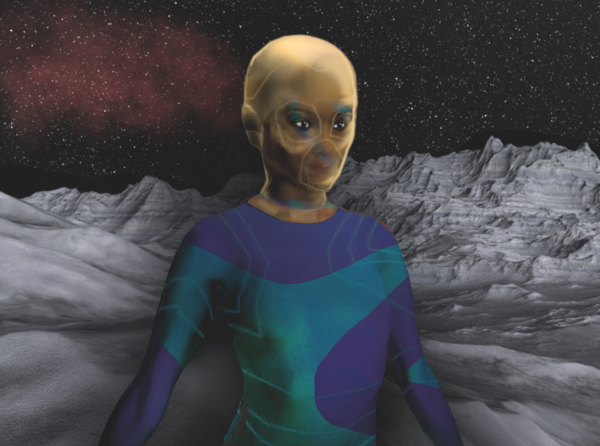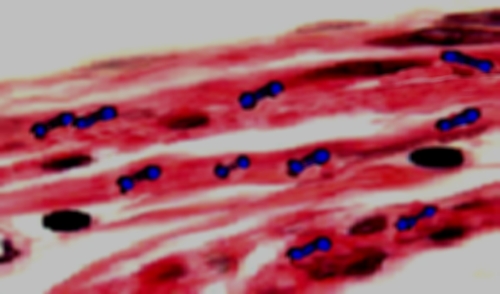BY LETTER
Vacuum Equipment
Technology > Application > Augmentics
Technology > Technology Type or Material > Drytech/Hylotech
Technology > Application > Envirotech
Technology > Technology Levels > High Tech / Hitech
Technology > Application > Medical Treatment
Technology > Technology Type or Material > Drytech/Hylotech
Technology > Application > Envirotech
Technology > Technology Levels > High Tech / Hitech
Technology > Application > Medical Treatment
Thinsuits, airdust, nanolungs; aids for survival in vacuum | |
 Image from Steve Bowers | |
| A Thinsuit with the collapsible airmask fully extended. | |
Vacuum Equipment
Terragen civilization has been a spacefaring culture, living in close proximity with vacuum and low-pressure environments, for thousands of years. One result of this has been the creation of a number of races and clades who are adapted in various ways for low pressure or vacuum conditions. Many of these beings are designed to literally live in deep space and have no need or desire to ever come into contact with even low levels of atmospheric pressure. Of these only a small minority are of biological descent. The majority of bionts still breath, and still require conditions of temperature and pressure that make protection from the deep space environment a necessity. As a result of this, mindkind has derived a number of technologies to both survive and thrive in the cold and airlessness of between the habitats and worlds. Image from Steve Bowers | |
| Airdust respirocytes (blue) seen in capillary tissue | |
Airdust
Airdust is a mesoscale oxygen transport system, capable of supplying oxygen to a biont user directly into their blood, which was first envisioned as far back as the Information Age by the technological philosopher Robert Freitas. It was not until the late Interplanetary Age, with the development of 'dry' nanotech, that the first primitive airdust technology was achieved. Airdust is a specialised form of respirocyte, and are one of the earliest and most widely used forms of nanomedical technology and nanotechnics in general.Designed originally as a medical device, airdust consists of huge numbers of nanotechic 'air tanks' each approximately 1 micron across and containing a small charge of air at 1000-atm pressure. Constructed of diamondoid, respirocyte tanks were more then adequate to contain such high pressure gases. Each respirocyte also contains a simple valve and pumping system that permits it to both take in atmospheric gases or release them.
Originally, airdust was developed as a medical enhancement or emergency replacement for human blood, allowing a massive charge of oxygen to be introduced into the body very quickly. Later advancements in the technology also allowed airdust to be used to remove CO2 or other gases, such as nitrogen from the body and blood.
A one liter 'augmentation dose' of 50% respirocyte solution injected into the bloodstream will permit a neb or baseline sophont to cease breathing for anywhere from 12 minutes to 3.8 standard hours depending on exertion levels. For sophonts preparing to travel into space, standard safety procedure is to receive an injection of airdust solution prior to departure. This provides a 'built-in' air supply in the event of an emergency loss of pressure as well as making external air tanks unnecessary for most extra-vehicular activities.
Since airdust particles can operate almost indefinitely inside a sophont body, and can be 'recharged' by several hours of normal respiration or some minutes of hyperventilation, even a single trip into space will leave a sophont with the ability to 'hold their breath' for hours from that point forward. Although nanotechic scrubbing can remove airdust from the body, most bionts don't bother, preferring to simply retain the enhanced breathing ability that airdust provides even if they never travel into space again.
On habitats and low-pressure/zero-pressure planetary colonies, initial airdust injections are usually made shortly after birth, with steadily increasing 'booster shots' being provided until the child reaches physical maturity and more comprehensive technologies (see Nanolung) can be provided.
In certain cyborg clades the airdust concept has been taken even further, with the blood fluid completely replaced by so-called vasculoid technology; a single, contiguous nanomedical oxygen supply system typically made of sapphiroid which allows for extended periods of operation in vacuum.
Nanolung
A nanolung is a direct extension of airdust technology. It provides a centralized docking station for 'onboard' airdust components and exchanges gases either with the lungs or with exogenous gas supplies. A user will charge up their airdust respirocytes using their nanolung facilities shortly before entering a vacuum environment, or before strenuous activity.While smaller nanolungs (250cm3, .3-7hrs O2 supply depending on exertion levels) are occasionally used for specialized purposes or by some cyborgs or frequent travellers, a more common solution is the replacement of one lung with a larger system (3250cm3) that provides from 4 to 87 hours of oxygen depending on exertion levels. A user with one or more nanolung systems can take a series of very deep breaths to charge their airdust, stopping when their internal monitoring systems indicate that the airdust is fully charged.
In many space based polities and habitats, nanolungs are commonly provided to all citizens upon physical maturity. Many societies and clades use the implantation of the nanolung as the opportunity to mark the transition to adulthood with everything from formal tattooing ceremonies, to celebrations, to extended sporting or sexual events during which no actual breathing takes place.
Thinsuit
Thinsuits are designed to provide 'short-term' protection from the rigors of space. They are nano-constructed devices that are intended to protect the wearer from the vacuum, temperature, and radiation extremes of space without having to contend with the various functions of the biont body such as eating, drinking, or voiding of wastes.The basic structure of a thinsuit is a somewhat rubbery looking layer of material of about 1mm thickness. Sensors and tactile feedback circuits in the suit cause it to transmit textures thru the suit to the wearer, while supporting nanobots clean both the suit and the wearer by absorbing and recycling/removing moisture and materials from sweat, body oils, and the flaking of dead skin. Nanoflywheel clusters dotted around the suit and partially recharged from body movements provide power, used for both general suit operations and low level magnetic shielding.
Thinsuits are smart matter devices that can flow and extend in a semi-liquid manner. Under normal conditions they are worn under the clothing (of those societies that employ clothing) with the hands, head, and sometimes feet uncovered. However, either at the users command or if a drop in air pressure is detected, the thinsuit will 'flow' to cover the wearers unprotected head and extremities, providing them with airtight protection in a matter of seconds.
Once deployed, the thinsuit then configures itself into a comfortable mask-like arrangement around the wearer's head, bulging out over the eyes, ears, nose, and mouth. Phased array display elements over the eyes allow the user to see across a wide range of the electromagnetic spectrum and provide text and graphic information as required. Vibrating membranes in the earpieces of the suit provide full-spectrum audio interfacing.
Combined with airdust or a nanolung, thinsuits allow the average biont to operate in (and in close proximity to) a vacuum environment with both ease and safety.
Related Articles
Appears in Topics
Development Notes
Text by Todd Drashner
Initially published on 27 October 2005.
Initially published on 27 October 2005.






